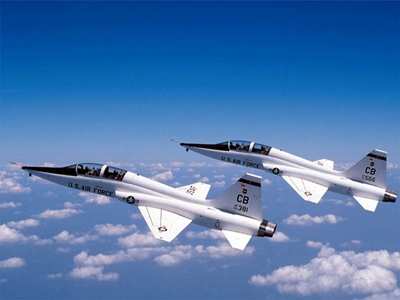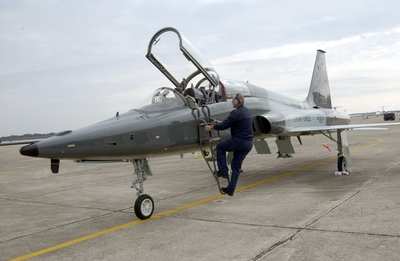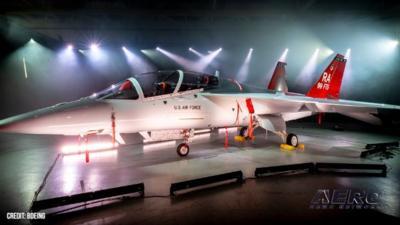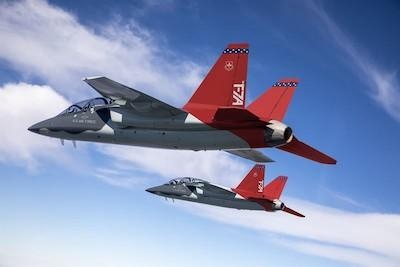Storied Jet Retiring After 61-Years and 50,000 Pilots Trained
Since it’s introduction 61-years ago, some fifty-thousand military pilots have trained in Northrop’s T-38 Talon.

In addition to serving the United States Air Force—the single largest operator of the type—the T-38 is in use with NASA, and the U.S. Naval Test Pilot School.
Worldwide, the T-38 serves numerous NATO militaries, to include those of Germany, Portugal, Turkey, and the Republic of China.
In September 2018, the USAF announced it would replace its T-38s with the clean-sheet, Boeing-Saab, T-7 Red Hawk.
As the long day of the T-38 Talon draws to a close, it is incumbent upon Americans to both acknowledge the greatness of the venerable aircraft, and glean some understanding of the promising new-comer by which it is to be replaced.

The Northrop T-38 Talon was the world's first supersonic trainer and is, to date, the most produced—with 1,189 specimens produced between 1961 and 1972. The T-38 is of conventional configuration, with a small, low-mounted, long-chord wing; a single vertical stabilizer; low-mounted, dual-stabilators; snd a tricycle undercarriage. The aircraft seats a student pilot and instructor in tandem. Intakes for its twin, General Electric, J85-5A after-burning turbojet engines are located bilaterally, along the lower-fuselage at the wing-root. Later models were upgraded to J85-5R powerplants, which produced 2,200-lbf dry-thrust, and 3,300-lbf with reheat.
In its J85-5R configuration, the T-38 was capable of reaching a maximum speed of 746-knots (1.3 Mach). The aircraft boasted a climb-rate of 33,600-feet-per-minute to a service ceiling of 50,000-feet. It’s superb performance earned the Talon the nickname White Rocket—and in 1962 the T-38 set absolute time-to-climb records for 3,000, 6,000, 9,000 and 12,000 meters, beating the records for those altitudes set by the F-104 in December 1958.
By contrast, the T-7 Red Hawk is a slightly larger, slightly lighter, somewhat slower, considerably more fuel-efficient machine.

Named in honor of both the Curtiss P-40 Warhawk and the Tuskegee Airmen, who famously painted the tails of their P-47 Thunderbolts and P-51 Mustangs bright-red, the T-7 is a conventionally-arranged aircraft featuring a high-mounted wing mainplane; twin, vertical tail-fins; and a tricycle undercarriage. The cockpit is aft of a slender, pointed nosecone, and the crew of two is seated in tandem beneath a lightly-framed canopy. The airframe exudes modernity and aerodynamic efficiency.
The T-7 is powered by a single, General Electric GE F404 series turbofan, which is fed via a split-air system with intake-ducts located bilaterally beneath the forward wing-extensions. The engine produces 11,000-lbf of dry-thrust, and 17,200-lbf with reheat. Maximum speed is a brisk, 702-knots while cruise speed is a comparatively leisurely 526-knots.

The T-7 is capable of climbing at 33,500-fpm to its service ceiling of 50,000-feet.
The Red Hawks MGTOW of 12,125-lbs is marginally heavier than the T-38’s 12,093-lbs, and its operational range of 1,143-statute miles bests the T-38’s 1,093-statute miles—albeit only slightly.
Under the extant, indefinite-delivery/indefinite-quantity contract, the maximum quantity of aircraft and training devices the Air Force can purchase is 475 and 120 respectively. The T-7 will be built in St. Louis, MO, with Saab providing the aircraft’s aft fuselage section and Boeing building the Red Hawk’s forward section, wings and tail assembly.
The first T-7A aircraft and simulators are scheduled to arrive at Joint Base San Antonio-Randolph, Texas, in 2023.
 Airborne 06.30.25: US v ADS-B Misuse, Natl STOL Fire, Volocopter Resumes
Airborne 06.30.25: US v ADS-B Misuse, Natl STOL Fire, Volocopter Resumes Aero-News: Quote of the Day (07.06.25)
Aero-News: Quote of the Day (07.06.25) ANN's Daily Aero-Linx (07.06.25)
ANN's Daily Aero-Linx (07.06.25) Classic Aero-TV: Portrait of the Army Aviation Heritage Foundation
Classic Aero-TV: Portrait of the Army Aviation Heritage Foundation Airborne-NextGen 07.01.25: Volocopter Returns, B23 Energic, Iran Tech In UAVs?
Airborne-NextGen 07.01.25: Volocopter Returns, B23 Energic, Iran Tech In UAVs?






